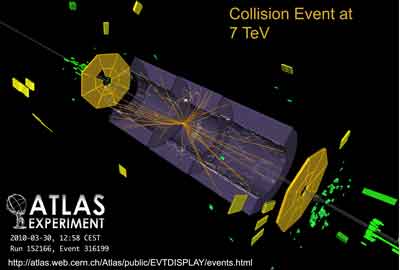 |
Southern Methodist University physicist Pavel Nadolsky will receive $750,000 over five years to fund his work in modeling particle interactions through a new program administered by the Office of Science, U.S. Department of Energy (DOE).
Nadolsky, assistant professor of theoretical physics in the SMU Department of Physics, received the grant for his integrated analysis of particle interactions created by hadron colliders. He was one of 69 researchers chosen through peer review by scientific experts to participate in the DOE’s new Early Career Research Program. About 1,750 applicants submitted proposals.
Funding meant to boost scientific workforce
Early Career Scientists receive funding under the American Recovery and Reinvestment Act of 2009 in an effort “to bolster the nation’s scientific workforce by providing support to exceptional researchers during the crucial early career years, when many scientists do their most formative work,” according to a DOE statement.
Nadolsky works with an SMU team of postdoctoral research associates and graduate students to model hypothetical interactions of subatomic particles for the biggest physics experiment in history: the Large Hadron Collider (LHC) near Geneva, Switzerland.
The LHC became fully operational on March 30, 2010, and the high-speed, high-energy particle collisions it creates will allow physicists to recreate conditions at the origin of the universe — and possibly discover the mechanisms that cause particles in space to acquire their differences in mass.
Tiny particle research aids search for new physics
As part of the effort to identify theoretical new particles such as the Higgs boson, Nadolsky develops highly detailed computer simulations both of known particle interactions and of the expected tiny deviations that LHC researchers hope to discover. Each collision produces a staggering amount of raw information, and the most useful bits are few and far between: Out of 40 million events per second, the researchers may be looking for as few as 10 events a year.
“The phenomena we’re looking for will be buried under a lot of known particles produced by ordinary means,” Nadolsky says. “Our task is to produce the most accurate models possible of known interactions, so we can recognize the interactions that deviate, and why.”
Without such models, identifying new events at the LHC would be difficult, if not impossible, he adds.
Nadolsky received his doctorate from Michigan State University in 2001 and joined SMU as a postdoctoral research fellow from 2001 to 2004. He also did postdoctoral research with the High Energy Physics Theory Group at Argonne National Laboratory in Illinois from 2004 to 2007. He returned to SMU as a faculty member in 2008. — Kathleen Tibbetts
Related links:
Lay person’s guide to particle physics
Pavel Nadolsky
SMU Group of Particle Phenomenology
Nadolsky lecture: Parton Distribution Functions
Department of Physics
Dedman College of Humanities and Sciences
 One of the first LHC collisions at the record energy of 7 trillion electron volts on March 30, 2010.
One of the first LHC collisions at the record energy of 7 trillion electron volts on March 30, 2010.